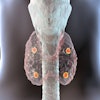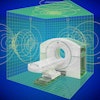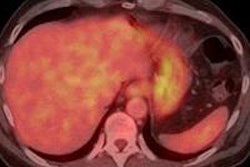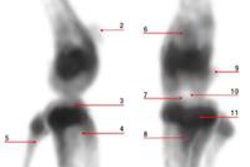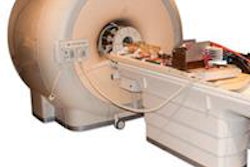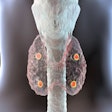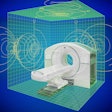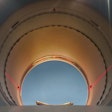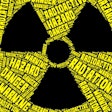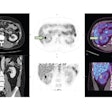
Two novel PET detector designs offer a significantly improved coincidence time resolution and may help better localize tumors within patients, report researchers from the Fondazione Bruno Kessler (FBK) in Trento, Italy, and the Swiss-based European Organization for Nuclear Research, known as CERN.
In PET imaging, more precise timing information on the coincidently detected gamma photons allows for improved suppression of background noise in the reconstructed image and better localization of the original decay event along the line of response between the two detectors. In current, top-of-the-line PET scanners, detectors have a working time resolution of around 400-600 ps, allowing tumors to be localized to within a 6-9 cm range along the line of response. In contrast, a machine with a time resolution of 200 ps would be able to reduce the range to just 3 cm.
In a recent article, the researchers report two new detector designs from FBK -- one built with a near-ultraviolet silicon photomultiplier (SiPM) and the other a red green blue-high density SiPM (Physics in Medicine and Biology, 28 May 2015, Vol. 60:12, pp. 4635-4649). In both devices, the SiPMs were coupled to lutetium oxyorthosilicate codoped with cerium and 0.4% calcium crystals, whose faster scintillation decay times (compared with nondoped lutetium oxyorthosilicate crystals) help give a reduced time resolution.
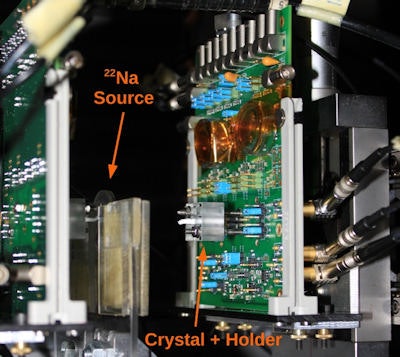 Experimental setup for coincidence measurements performed at CERN. Image courtesy of Stefan Gundacker.
Experimental setup for coincidence measurements performed at CERN. Image courtesy of Stefan Gundacker.Dr. Craig Levin, a radiologist from the Stanford University School of Medicine in California who was not involved in this study, notes that the researchers' coincidence time resolution values are the best reported, and "represent an important advance toward the lower timing resolution bound possible from theoretical considerations."
Thinking of potential clinical applications, Levin thinks it will be important to expand the setup to include arrays of crystals and SiPM pixels, as well as a scalable data acquisition method that can be practically implemented in a full PET system. In addition, the common custom of reducing the number of readout channels in practical systems -- by multiplexing crystals to photomultiplier arrays -- would see a corresponding decrease in the time resolution achieved in the one-to-one experimental setup.
Details of Italian/Swiss research
To demonstrate the validity of their measurements, the authors conducted tests of both devices at both the FBK and at CERN, using standard test equipment, but with different electronic setups at the two testing sites.
Both tests reported similar and improved timings with the two detectors, with the best coincidence time resolution seen for the 2 x 2 x 3 mm crystals of only 85 ps -- an experimental record. For longer, 2 x 2 x 20 mm crystals of the size employed in current-generation PET systems, the best coincidence time resolution measured was 140 ps.
"Both the crystals and silicon photomultipliers contribute to the low values of the measured coincidence time resolution," said lead author Mythra Varun Nemallapudi, a researcher at CERN. "The silicon photomultipliers used in these measurements are the state-of-the-art devices produced by FBK which have very good values of single photon time resolution, a faster rising edge of the signal, and are able to better extract the scintillation light from the crystal."
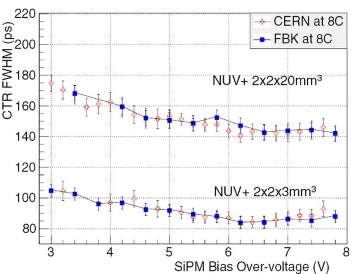 Coincidence time resolution measurements at CERN and FBK. Above: NUV SiPM as a function of bias overvoltage. Below: RGB-HD SiPM as a function of bias overvoltage.
Coincidence time resolution measurements at CERN and FBK. Above: NUV SiPM as a function of bias overvoltage. Below: RGB-HD SiPM as a function of bias overvoltage.With their initial study done, the researchers are continuing to develop their detectors. In addition, the team will be expanding their work to look not only at the detection of 511 keV gamma rays for PET scanners, but also at levels suitable for high-energy physics applications, where fast timing is an important factor.
© IOP Publishing Limited. Republished with permission from medicalphysicsweb, a community website covering fundamental research and emerging technologies in medical imaging and radiation therapy.
